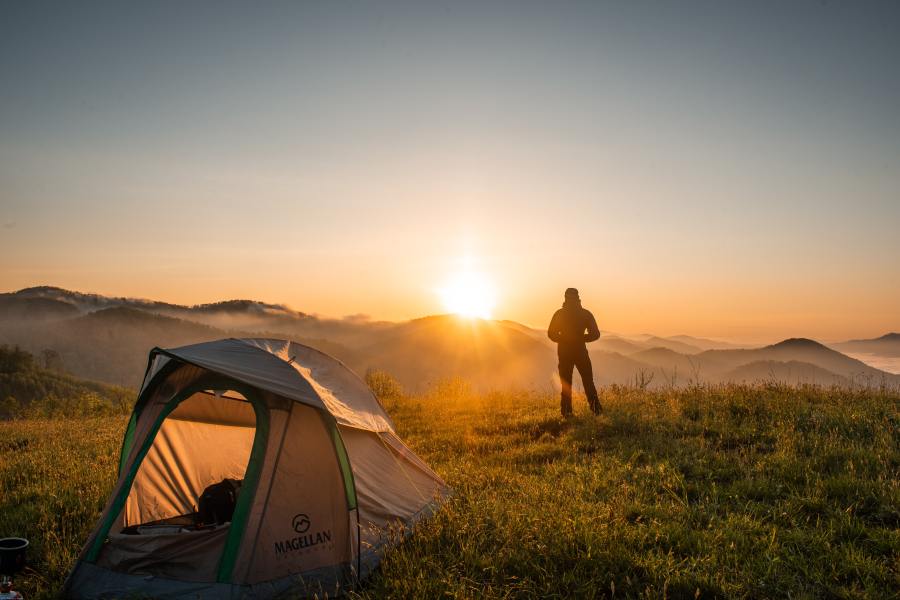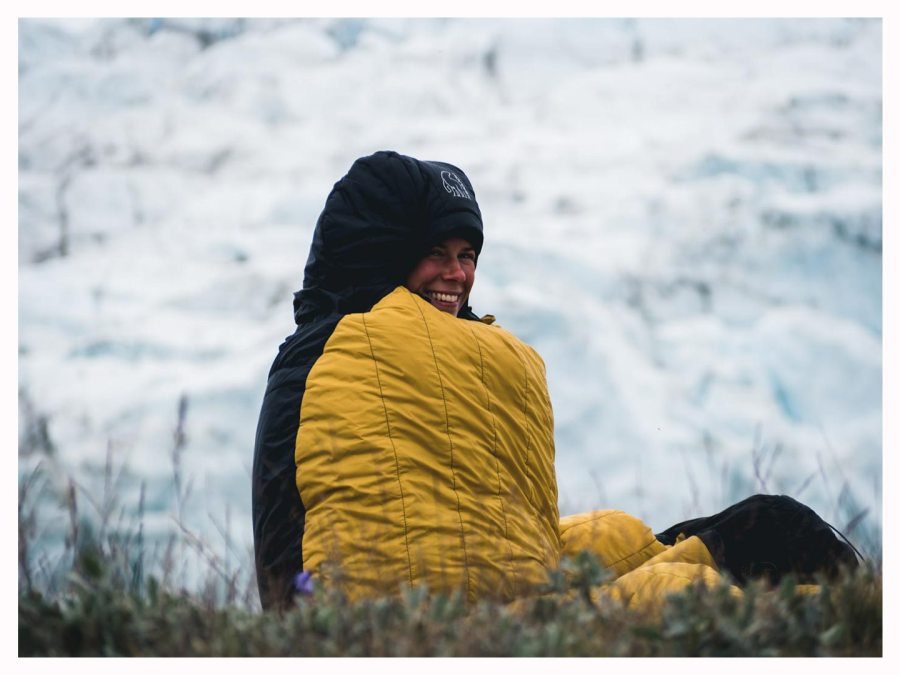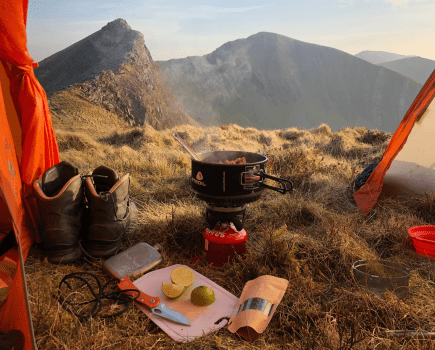Camping and backpacking are outdoor pursuits that can be enjoyed year-round. Camping in high summer is a different prospect to camping in deep midwinter, especially in variable climates. This means that you’ll likely need to use different sleeping bags depending on the season, a range of sleeping bags can be found in our guide to the best sleeping bags. Alternatively, it is sometimes possible to build a more versatile sleep system. This can then be adapted to cope with a broad range of temperatures.
Words: Matthew Jones | Main image: Nordisk
In this simple guide, we’ve explained these two approaches. This will help you to understand the different types of sleeping bag, giving you all the info needed to make an informed decision on the right system for you.
What sleeping bags season ratings mean
A season rating is used to indicate the time of year for which a sleeping bag is most suitable. This corresponds to the four seasons of spring, summer, autumn and winter, or a combination of these. So, for example, ‘one season’ bags are designed for summer use, while ‘three season’ bags can be used throughout spring, summer and autumn. ‘Four season’ bags are designed for winter use.
What sleeping bag temperature ratings mean
You should try to select a sleeping bag based on the lowest night-time temperatures you expect to camp in. However, take into consideration your own physiology, i.e. whether you’re a warm or cold sleeper. If in doubt, opt for a sleeping bag with a temperature rating that goes a few degrees below the conditions you’re expecting.
The temperature ratings that are quoted on modern sleeping bags are based on the EN 13537 or ISO 23537 standards. These tests analyse a sleeping bag’s realistic temperature range. The test is standardised, which makes the figures useful when comparing the warmth of different sleeping bags on the market. Again, we’ve covered all this in more detail in our article on how sleeping bag ratings and temperatures work.
In summary, if you’re camping in the height of summer, you may only need a one-season bag. If you’re camping in deep winter, you’ll almost certainly need a four-season bag.
What sleeping bags do I need for summer camping?
Summer is prime camping season, and the most popular time for people to spend nights in the great outdoors. The prospect of balmy, clear nights tempts us to book a pitch on a campsite or head for the hills.

Image: Cliford Mervil/Pexels
At the height of summer, you might be more concerned about being too warm at night rather than getting cold, in which case, do you even need a sleeping bag? In most cases, it’s still a good idea. In many parts of the UK, summer nights are still too cold to sleep outdoors without a sleeping bag. There are, however, other options than sleeping bags for warm temperatures.
Alternatives to warm-weather sleeping bags
Check out our article on alternatives to sleeping bags to get an idea of other viable sleep systems, including liners, blankets, hammocks and backpacking quilts. The latter in particular is often preferred by many summer backpackers. They offer greater versatility, ventilation and freedom of movement, as well as their low weight and bulk.
You might also consider a rectangular or semi-rectangular shape sleeping bag. These are less thermally efficient than mummy-style bags. In summer that’s not much of an issue and, in fact, might be a benefit. They also feel less restrictive and can be fully unzipped. They can then be folded out and used as a quilt. Rectangular or semi-rectangular shape sleeping bags are often an affordable option for warm-weather campers and backpackers, too. Check out our article on the different types of sleeping bag for more information.
Of course, it’s important to remember that night-time temperatures can often dip sharply, regardless of the season. What is forecast to be a mild night might end up becoming chillier by the early hours of the morning, especially if the wind picks up. This is particularly true if you’re camping higher up in the hills. Here, the air temperature will be colder than at sea level, especially on crisp, clear nights. So, while temperatures down in the valley might feel warm, you might still find it is cold up in the mountains.
Warm-weather sleeping bags
Still, even if wild camping, it’s true that in most cases, a 1- or 2-season bag with a comfort temperature rating of 5°C or above will be adequate for UK summer use. The advantages of these sleeping bags are that they are very lightweight and packable. This makes them ideal for warm-weather backpacking and bikepacking adventures.
Most 3-season sleeping bags are also suitable for summer use. In fact, this is the most versatile type of bag, so if you only intend to buy one sleeping bag, a 3-season bag is the way to go. The greatest risk is that some 3-season bags might feel a bit too warm in high summer, causing you to overheat. A good way to get around this is simply to unzip your bag for greater ventilation or to wear fewer (or lighter) layers at night. Look for a bag with a full-length zipper for maximum adaptability.
It’s also worth considering sleeping bags that offer additional ventilation. For example, some feature foot vents, enabling you to stick your feet out on warm nights. Others have zips on both sides that allow you to either fold down the top of the bag or free your arms, both of which can help to provide useful cooling when the weather is mild. Some bags like the Nemo Riff have zipped core vents or ‘gills’ that can be used to increase airflow, so you don’t overheat at night.
What sleeping bags do I need for winter camping?
Winter camping is a very different prospect to camping in other seasons. As such, it requires higher performance kit. When it comes to sleeping bags, this means you will need a significantly warmer bag – one with at least a three-season rating (and probably a four-season rating in most cases). You’ll want a bag with a comfort temperature rating of well below 0°C, sometimes -10°C or lower, depending on the conditions.
If you’re a very warm sleeper or only camping in early winter, when there is no frost on the ground, you might be able to get away with a 3-season bag. But it’s almost always worth bringing a full set of warm layers to sleep in (a long-sleeved base layer top and tights, hat, gloves, thick socks) and perhaps boosting your sleep system with the addition of a sleeping bag liner and/or an extra top layer, such as a down quilt. Also, make sure that your sleeping mat is warm enough for winter conditions. It will need to have an R-value of at least 4.0. It’s also worth reading our ‘10 tips to stay warm while camping’ in our article on how sleeping bags work.
When there’s snow
If there’s snow on the ground or you know that overnight temperatures will reach -5°C or below, you need a 4-season bag. These sleeping bags will almost always use a performance mummy shape. They also use premium (800FP+) down fill in a box wall construction for maximum thermal efficiency. Additional features include padded zipper baffles and draught collars, as well as a heavily insulated hood and footbox. While there are some 4-season synthetic bags on the market, they tend to be very heavy and bulky, which limits their practicality for wild camping or backpacking trips. They can work well for basecamp use though, or if conditions are likely to be very damp as well as cold.
Our advice? Take a 4-season bag in any situation where getting your sleep system wrong could pose a risk to your health, such as when camping solo or in remote upland areas.








